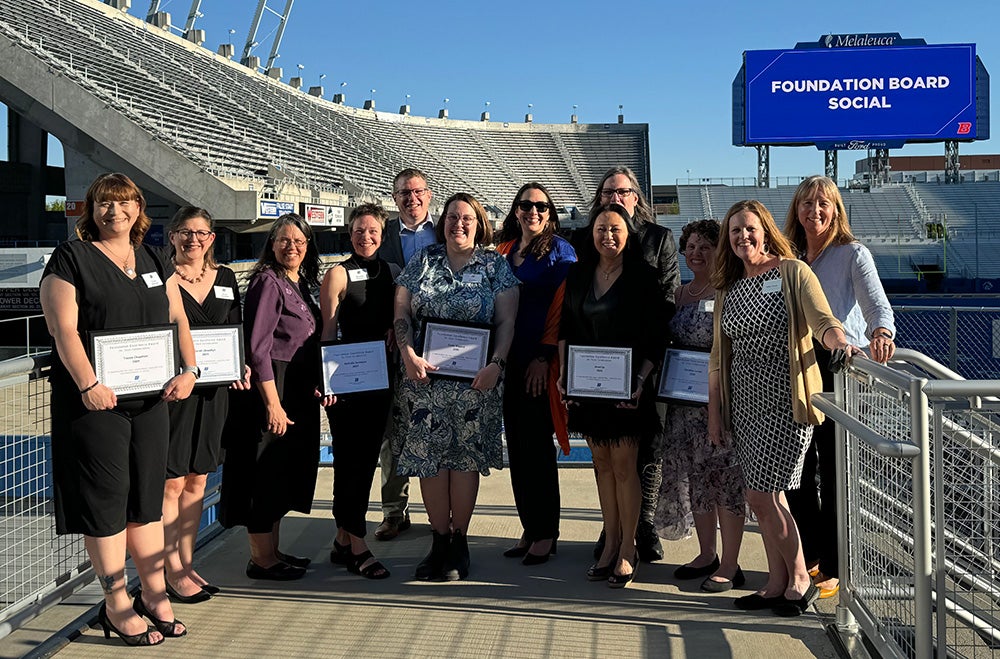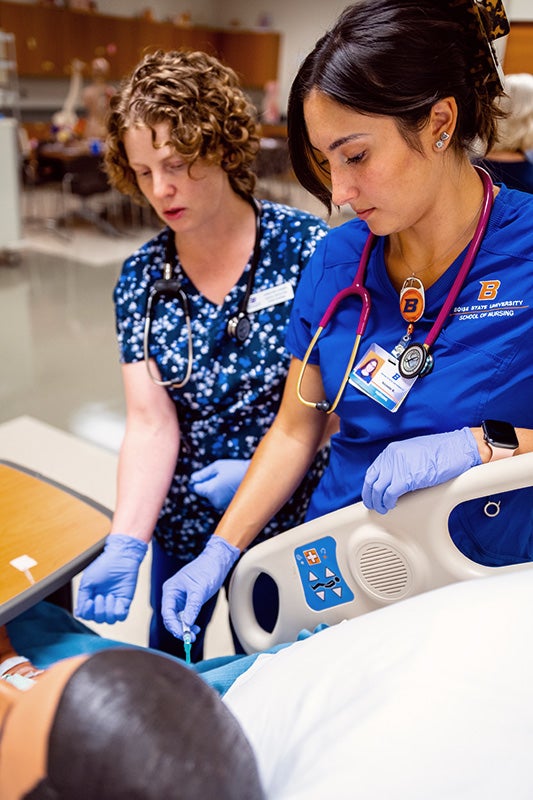The magic of academic success rarely starts on the first day of classes. More often than not, a hardworking team of faculty and staff has been active behind the scenes months in advance to ensure students have high-quality learning experiences. This year, the Boise State University Foundation recognized a team from the School of Nursing. They received the “Excellence Award for Team Collaboration” for their innovative overhaul of the pre-license nursing curriculum for simulation.
“These efforts demonstrate collaboration within our department and community organizations, a willingness to be creative and go above and beyond to create learning opportunities, and a dedication to our students,” said School of Nursing Interim Divisional Dean Kelley Connor.
New technologies for student success
The team’s nomination emphasized their commitment to incorporating multiple modern workplace technologies into students’ education. A significant part of this was collaborating with St. Luke’s Health System to give students access to a sandbox version of their EPIC electronic health records system.
“Implementing this required significant modifications to their undergraduate pre-license curriculum, offering students a chance not just to learn, but also to practice and receive invaluable feedback from their instructors,” said Reid Stephan, St. Luke’s Health System vice president and chief information officer, in his nomination letter.

Clinical Assistant Professor Jason Blomquist also created a remote patient monitoring dashboard and simulation activity. An increasingly necessary skill in our digital healthcare age, students practice using patient data to monitor trends and care for patients.
The new curriculum ensures students learn and practice safe medication administration “in an environment where patients are safe from any potential mistakes or lack of understanding,” Connor said.
This is due in part to the ingenuity of clinical instructor Christine Larsen. Using her skills in computer programming, Larsen built an original NURSTEC medication administration system.
Thanks to the Simulation Center staff members – who integrated the NURSTEC system by creating medication barcodes, becoming NURSTEC superusers and creating student login codes – students have increased access to and practice with healthcare technology before they begin full-time careers.
“I commend Boise State for ensuring that our future healthcare workers are equipped with the necessary skills to use these tools effectively,” Stephan said.
Scaffolded learning increases students’ confidence
“We have this group of passionate and innovative faculty and staff who like to have fun, aren’t afraid to try new things, and create experiences that meet course objectives and program outcomes,” said Tracee Chapman, director of simulation-based education and research.
The team took a new approach to immersive clinical experiences, overhauling the curriculum to scaffold student learning.
They moved away from a one-time, check-off method of skills practice and assessment to incorporate “raw” nursing skills – like inserting an IV – with patient stories. These storylines establish context for the skill and grow in complexity as students advance through the baccalaureate program.
“We’re helping build their clinical judgment while continuing to practice skills instead of just a one-and-done mentality,” Chapman said.
“We’re not building task-makers, we’re building nursing students who can think and decide what’s best for a patient clinically.”– Tracee Chapman
Students are paired with one instructor throughout a course, so faculty can track their growth over the semester more accurately and mentor them through their skills. Based on student feedback, these changes are extremely effective.
“Students feel comfortable, and they love it,” Chapman said. “Their confidence is what’s driving us to keep building these clinical scenarios. We have all felt the student change in those rooms and find joy in teaching this way.”
Innovation in response to community needs
But before these advancements came about, the team’s curriculum overhaul began with innovative documentation. Kaylin Holmquist, School of Nursing instructional design analyst, developed an original “suite of home-grown tools to seamlessly interconnect and automate the process of data-gathering and curriculum assessment,” Connor said.
Connor praised Holmquist’s creation. It uniquely automated their curriculum process and provided dynamic visualization that allowed the team to “pinpoint gaps and identify opportunities for curriculum scaffolding.”

Thanks to the team’s efforts, Boise State leads the field in cutting-edge nursing curriculum. Their work is crucial to student success based on feedback from the School of Nursing’s Strategic Advisory Board.
The regional healthcare leaders provide input on current nursing workforce needs and trends. They indicated that graduates “required greater attention to skills, competencies and clinical judgment to meet complex health needs in a constantly evolving healthcare system,” Connor added.
The team worked diligently to deliver, and it paid off.
“I am thrilled that Boise State has worked to increase opportunities for student practice by updating the curriculum and providing learning experience using technology tools,” said Misty Robertson, chief operating officer and chief nursing officer of St. Luke’s Nampa and Fruitland Medical Centers and a board member, in her nomination letter.